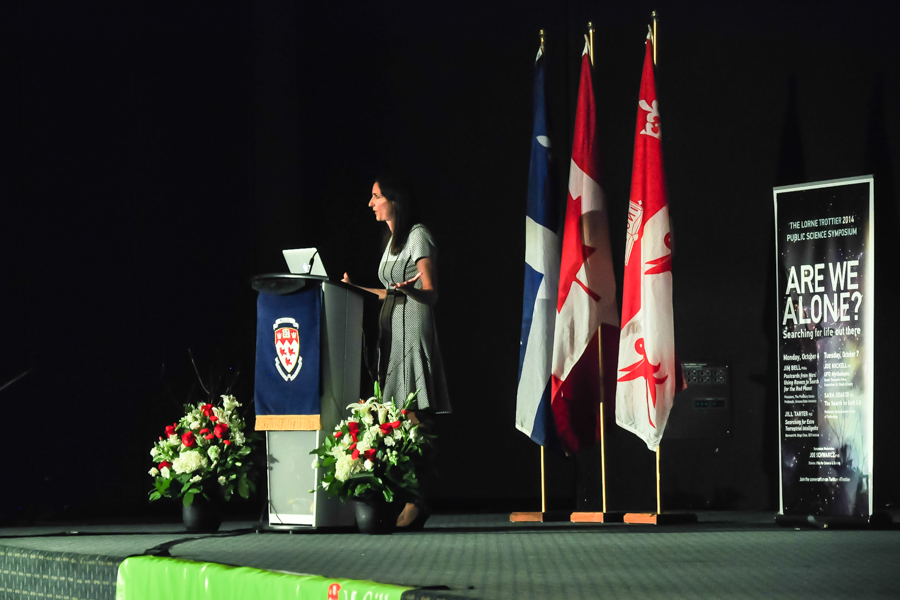The Lorne Trottier Public Science Symposium is an annual event hosted by McGill, and featuring prominent scientists, that addresses and discusses current and provocative topics with society. Previous lecture topics have included pseudoscience, alternative medicine, and nutrition, all with the aim of being informative and raising public awareness. The 2014 Symposium, moderated by Professor Joe Schwarcz, asked the grand question: “Are We Alone?” Schwarcz, a McGill chemistry professor and director of McGill’s Office for Science & Society, has been a key figure in advocating organizing public outreach events and quelling pseudoscience.
Scientists, armed with the empirical eyes of astrophysics, are scanning the universe in search of extraterrestrials, but are yet to uncover any cosmic cousins. Meanwhile, despite the absence of any tangible evidence, belief in extraterrestrial visitations and reported sightings are rampant. Legendary physicist Richard Feynman, when asked whether or not he believes in flying saucer visitations, responded,“I think it is much more likely that the reports of flying saucers are the result of the known, irrational characteristics of terrestrial intelligence rather than the unknown, rational characteristics of extraterrestrial intelligence.” However, the vastness of the cosmos, home to about one hundred billion galaxies, each populated by about one hundred billion suns, led the inimitable astronomer Carl Sagan to believe that the likelihood of extraterrestrials existing exceeds the likelihood of Earth being the only planet from which life arose.
Professor Jim Bell, a visiting scientist at NASA’s Jet Propulsion Laboratory in Pasadena, California, spoke at the event about NASA’s exploration of Mars by launching rovers to explore the habitability of the red planet. The rovers comprise Spirit and Opportunity, which launched in 2003, and Curiosity, which launched in 2011. These rovers differ from the unmanned NASA probes, such as Viking, in terms of enhanced mobility and navigation. The ‘robot geologist’ rovers include mechanical arms, microscopic imagers, and scientific instrumentation to analyze soil and rock composition, meteorology, hydrogen content, and chemical isotopes. Bell explained that, although Mars is a cold and dry planet with a thin atmosphere, the rovers have accumulated evidence of ancient river valley networks and mineral pattern formations that plausibly required water. If the cosmic clock could be turned back, it’s possible that Mars was previously Earth-like.
Nickell also argued that many alien abduction reports are attributable to sleep paralysis, in which the body is paralyzed and the individual experiences intensely fearful hallucinations, characterized by a presence culturally interpreted as an alien, witch, or ghost.
Jill Tarter, famously portrayed by Jodie Foster in the film Contact, holds the Bernard M. Oliver Chair for SETI (search for extraterrestrial intelligence) Research at the SETI Institute. Using optical and radio telescopes, SETI searches for evidence of technological signals, which are treated as a proxy for intelligent life. Tarter, stating that “it takes a cosmos to make a human,” explained that the elements required for life, such as the iron found in haemoglobin, were cooked inside of stars that exploded. “We are stardust.” SETI’s telescope technology is increasing exponentially, in accordance with Moore’s Law, and telescope assemblies are growing from the present 42-telescope array to much larger projected 350-telescope arrays. Tarter explained that evidence of extraterrestrials may give humans hope that we can survive our technological adolescence without destroying ourselves. The mission of SETI, according to Tarter, is to “discover what the rest of the stardust in our universe has turned into.”
Professor Sara Seager is a planetary scientist, astrophysicist and 2013 MacArthur fellow. She is searching for planets orbiting stars other than our sun, dubbed exoplanets, earning the title of “astronomical Indiana Jones.” Fascinatingly, the search for exoplanets suggests that each star should have at least one orbiting planet. Seager is probing the universe for exoplanets in the “goldilocks zone,” that are not too hot or too cold but just right for sustaining life. She explained the difficulty in detecting exoplanets, analogous to trying to see a firefly in the glare of a searchlight. However, the brightness of a star dims as a planet transits in front of it, and if this dimming is regular and predictable, we can determine the planetary period. Given the enormity of space, Seager explained that we cannot yet visit any exoplanets. To illustrate, the space probe Voyager travels at 20 km/second, requiring 70,000 years to reach the nearest star. Although we cannot yet visit, we can detect traces of gases in an exoplanet atmosphere that might be attributable to life. As a planet transits in front of a star, starlight beams through its atmosphere, allowing astrophysicists to identify elements such as water vapour, sodium, and potassium gas. Detecting oxygen in an exoplanet atmosphere would be exciting, as Earth’s atmospheric oxygen is produced by plants and photosynthetic bacteria. One day, Seager wishes to point to the sky and say “that star has a planet like Earth.”
Joe Nickell, Senior Research Fellow of the Committee for the Skeptical Inquiry, addressed the mythology of UFOs. Nickell explained that he’s not a “dismissive, arm-chair, put-downer” debunker, but rather, an investigator who does fieldwork and searches for evidence of purported claims. Nickell presented the history and variety of two modern mythologies: Big Foot and extraterrestrials. He proposed that extraterrestrials represent projections of our future selves, with oversized brains and vestigial bodies. He also presented images of crop circles that he physically produced, identical to those supposedly created by aliens. Nickell also argued that many alien abduction reports are attributable to sleep paralysis, in which the body is paralyzed and the individual experiences intensely fearful hallucinations, characterized by a presence culturally interpreted as an alien, witch, or ghost.
The four incredibly entertaining speakers illuminated the imagination and curiosity of the audience, without sensationalizing the science. Although there is, as of yet, no evidence of technological whispers from other worlds, scientists are actively listening, scanning, and exploring with equally open and skeptical minds.

